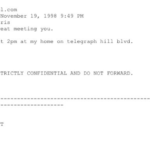Jeffrey Katzenberg’s streaming service Quibi is doing a show about Snapchat’s founding
Jeffrey Katzenberg and Meg Whitman today announced a slate of new series and projects heading to their forthcoming video streaming service, Quibi. The list includes an origin story to complement Telemundo’s hit show “El Señor de los Cielos;” a music competition show produced by Justin Bieber manager and entertainment exec Scooter Braun; a show from Jennifer Lopez’s company about the power of giving and paying it forward; as well something called “Frat Boy Genius,” which will focus on the rise of Snapchat — and specifically its creator, Evan Spiegel.
“It is the story of how he built and created Snapchat, which is one of the great social platforms of our time,” touted Katzenberg. “And we want to tell a story that is as compelling and interesting about the creation of Snapchat and Evan’s story as “[The] Social Network” was for Facebook,” he added.
The project will be based on the screenplay by the same name, which had written Spiegel as a hard-partying Stanford student, according to Vulture’s review of the much-hyped script.
“He should be flattered,” remarked Katzenberg, of Quibi’s plans for the Spiegel-focused project.
And now to the featured scripts! First up: @Elissits‘ FRAT BOY GENIUS, illustrated by @boxbrown. pic.twitter.com/GW8KQclrrB
— The Black List (@theblcklst) December 17, 2018
Katzenberg and Quibi CEO Meg Whitman were at SXSW to speak about the upcoming streaming video service, which plans to offer short-form video designed for mobile. On Quibi, consumers watch “quality” video cut into smaller pieces, including both scripted and unscripted original content, exclusives from Quibi’s partners and other daily news and sports programming.
Already, some of Quibi’s content plans have been announced.
For example, Deadline reported last fall that filmmakers Sam Raimi, Guillermo del Toro and Antoine Fuqua and producer Jason Blum will all create series for the service. And a pitch deck had touted other examples of Quibi’s programming — like a show called “Inspired By” with Justin Timberlake and “Under the Gun” with Kobe Bryant. Plus, Katzenberg himself had revealed in a LinkedIn post that Quibi was working on a basketball-related series with Steph Curry’s production company.
However, the story about Snapchat’s founding highlights how Quibi could benefit from its combination of tech and entertainment industry roots, in terms of deciding what to greenlight.
Whitman, a former HP Enterprise president and CEO, also pointed to another example: her penchant for using data to make decisions.
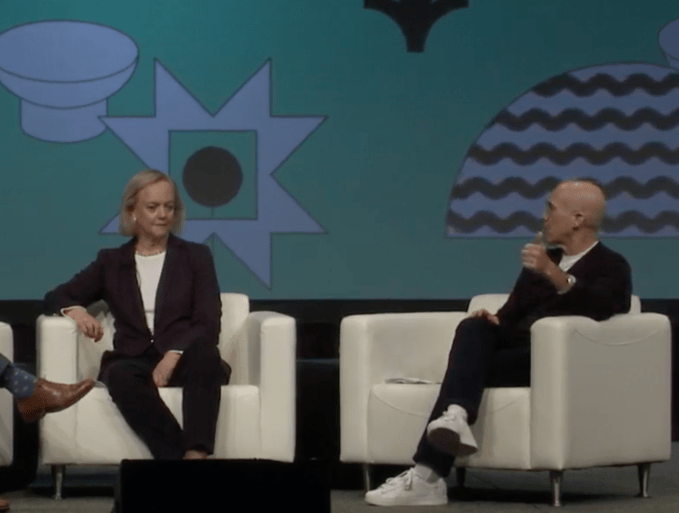 “I am deeply analytical and Jeffrey will argue in stories and allegories,” Whitman said. “And I will say: ‘Jeffrey, do you have any data to suggest that what you have just said is true?’ And he’ll say, ‘no I don’t have any data — but it’s true,’ ” she explained.
“I am deeply analytical and Jeffrey will argue in stories and allegories,” Whitman said. “And I will say: ‘Jeffrey, do you have any data to suggest that what you have just said is true?’ And he’ll say, ‘no I don’t have any data — but it’s true,’ ” she explained.
“Then I will come with data, facts, total available market size, market segmentation, market research, and he will say, ‘you know, not everything yields to analysis.’ And I’ll say ‘no, not everything does, but most things do,’ ” she said.
For the most part, today’s onstage discussion was a pitch for why Quibi will work and why it needs to exist — with Katzenberg touting its promise as an app that will benefit from 5G mobile networks as well as the cord-cutting behavior among younger millennials, who are no longer interested in traditional pay TV.
Both execs also stressed that Quibi was not a Netflix or YouTube competitor — despite angling for the same share of consumers’ mobile minutes and a set amount of downtime not spent on social media and mobile gaming, for example. They instead believe Quibi will be additive, and other services — like Netflix and Disney+ — can still win, even as Quibi wins.
Katzenberg said that Quibi aims to grab 20 minutes of the 70 minutes per day people spend watching short-form video, but doesn’t believe it will necessarily come at the expense of YouTube or others.
“Six years ago it was six minutes. A year and a half ago, it was 40 minutes. And today it’s 70 minutes,” he said, illustrating mobile video’s rise. “People love being able to watch great short-form content on the go.”
“What we know is that our users are watching a lot of video on mobile. They’re excited about the opportunity to see something differentiated. But honestly, we’re using a lot of judgment, and we’ll know whether it works when it launches,” Whitman added.
Quibi will publish more than 100 pieces of content every week, meaning it’s going to be making 5,300-5,400 pieces of content per year, Katzenberg said. He also mentioned a few others examples of programming, including a daily round-up of the best of late night TV, and spoke more vaguely of the potential for a show that delivered music news, the way that MTV’s Kurt Loder once did.
The streaming service is launching in April 2020, Katzenberg also confirmed today, putting a more definitive time stamp on the launch time frame beyond “early 2020” or “spring.”
Powered by WPeMatico
UK military veteran launches crowd-funding for Pixie app to revive local stores
What if, instead of sitting on your phone on the sofa ordering stuff from Amazon, you could buy the same things locally from local stores that ultimately enliven and enrich your local neighborhood? What if by doing that, you wouldn’t be walking through deserted main streets, past boarded-up shops, dark alleys and graffiti? What if someone created a marketplace for independent businesses, local events and experiences that kept the money in the local economy rather than being siphoned off into global giants who don’t care about human-scale communities?
That’s the idea behind Pixie, a new take on the “shop-local app” startup model which, although it’s been tried before, has never quite managed to take off. Perhaps Pixie will have more luck?
Here’s how it works: The Pixie app connects people to independent businesses through a curated marketplace, incentivizing them to pay through the app and get rewarded for being loyal customers. Integrated into the app is Pixie Pay, a bespoke payment solution which keeps money in local hands.
The startup has a fascinating background. Whilst serving in the British Special Forces, Pixie’s founder Greg Barden understood that his mission was also to ‘win hearts and minds’ with the local population. Whether by buying bread from the local baker in a village in Afghanistan, or coffee from the market in Baghdad, he and his soldiers could tear down even the most hostile barriers.
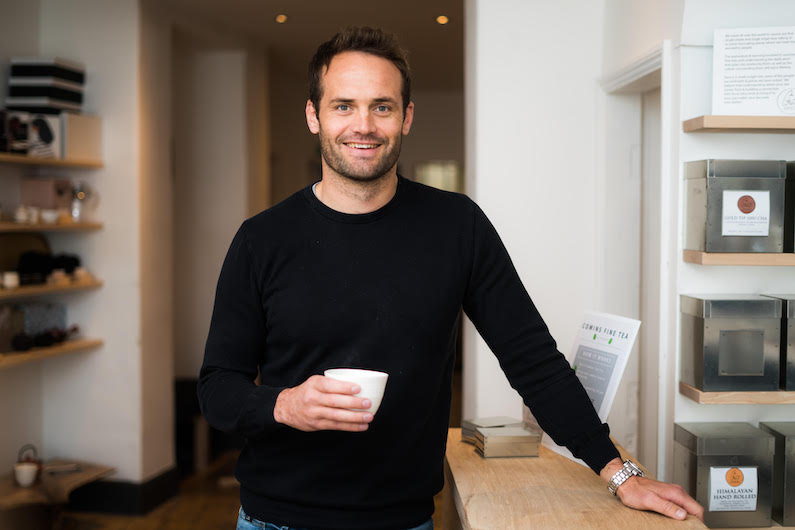
He also realized that when more money stayed inside these the local economies rather than being sucked away by organized crime or large scale, globalized businesses, the local economy might flourish and the risk of the societies there becoming yet again destabilized could potentially diminish.
“Whether it was stalls in the bazaars of Baghdad or small boutiques on Bath high-street, I realized independent shop owners are linchpins in their community. They add variety to the mundane and nurture community spirit. Even local guardians need protecting sometimes, which is why we created Pixie.”
The threat to independent stores from globalization and digitization isn’t just happening in Afghanistan. Across the western world, ‘Main Street’ stores are closing at a prodigious rate. In the UK over 1,500 local stores closed in 2018. (And that was BEFORE Brexit…)
Pixie has stress-tested its idea in mid-sized town in the UK, including Bath, Frome and Sherbourne, completing transactions across 250 businesses, ranging from cafes to fashion boutiques, and spinning up 5,000 app users. It’s now going on the fund-raising trail, aiming to raise £500,000 in funding through its ‘Equity for Explorers’ campaign on Crowdcube a UK-based crowd-equity platform. The total addressable market for independent business in the UK is estimated to be £31.5bn in gross transactional value.
Barden — who last year spoke about his startup life at the launch of the military tech non-profit TechVets — says: “There might be thousands of independent businesses across the UK, but at the rate the high-street is disappearing they are severely under threat. Pixie isn’t here to turn people away from the bigger players on the high-street, but create opportunities for enriching discovery. Needless to say, in a world with increasing nationalism, Brexit, Trump and — dare I say it — Amazon, we feel Pixie has a huge part to play in countering the worst aspects of globalization.”
Pixie’s revenue comes from transaction fees taken when people use its ‘Pixie Pay’ payment mechanism. The payment system is designed to bypass Visa/Mastercard at the point of sale, whilst the loyalty scheme unites independent businesses under one umbrella, so the users can earn and spend their loyalty points (as money) across the entire Pixie community. If a store using Pixie is in Australia, a person from Bath could also use their points there. This keeps the money circulating inside local, independent stores, wherever they are on the planet.
Pixie distributes its own payment terminal that sits next to whatever the business has in place to take normal card payments (iZettle etc). The cards are contactless but don’t utilise visa MasterCard. It’s literally their own e-money system. Think PayPal where users can either add money to their balance by debit card or bank and/or link a debit card to Pixie if they don’t have a balance.
Obviously this also creates it an alternative to competitors like iZettle, Square, SumUp and WorldPay, but this time specifically aimed at local independent stores, not huge national and international chains.
The third element of Pixie is its discovery marketplace that gives its community of explorers (users) the ability to discover local businesses across the Pixie footprint of stores.
I’ve seen several startups try and tackle this problem, but it may well be that Pixie, under its charismatic leader, finally has a shot at cracking this idea around local markets.
Powered by WPeMatico
Foursquare’s Hypertrending helps you spy on the coolest local happenings
Ten years after the launch of Foursquare at SXSW, the company is laying its technology bare with a futuristic version of its old app that doesn’t require a check-in at all. The godfather of location apps is returning to the launchpad with Hypertrending, but this time it hopes to learn what developers might do with real-time info about where people are and where they aren’t.
Hypertrending uses Foursquare’s Pilgrim technology, which is baked into Foursquare’s apps and offered as a third-party enterprise tool, to show where phones are in real time over the course of SXSW in Austin, Texas.
This information is relayed through dots on a map. The size of those dots is a reflection of the number of devices in that place at a given time. Users can filter the map by All places, Food, Nightlife and Fun (events and parties).
Hypertrending also has a Top 100 list that is updated in real time to show which places are super popular, with arrows to show whether a place is trending up or down.
Before you throw up your hands in outrage, the information on Hypertrending is aggregated and anonymized (just like it is within Pilgrim), and there are no trails showing the phone’s route from one place to another. Dots only appear on the map when the phone arrives at a destination.
Hypertrending was cooked up in Foursquare’s skunkworks division, Foursquare Labs, led by the company’s co-founder Dennis Crowley .
The feature is only available during SXSW and in the Austin area, and thus far Foursquare has no plans to launch this publicly. So… what’s the deal?
First and foremost, Hypertrending is about showing off the technology. In many ways, Hypertrending isn’t new at all, in that it runs off the Pilgrim technology that has powered Foursquare since around 2014.
Pilgrim is the tech that recognizes you’ve just sat down at a restaurant and offers up a tip about the menu on Foursquare City Guide, and it’s the same tech that notices you’ve just touched down in a new city and makes some recommendations on places to go. In Swarm, it’s the tech that offers up a list of all the places you’ve been in case you want to retroactively check in to them.
That sounds rather simple, but a combination of Foursquare’s 10 years’ worth of location data and Pilgrim’s hyper-precision is unparalleled when it comes to accuracy, according to Crowley.
Whereas other location tech might not understand the difference between you being in the cafe on the first floor or the salon on the second floor, or the bar that shares a wall with both, Pilgrim does.
This is what led Foursquare to build out the Pilgrim SDK, which now sees more than 100 million user-confirmed visits per month. Apps that use the Pilgrim SDK offer users the ability to opt-in to Foursquare’s always-on location tracking for its mobile app panel in the U.S., which has grown to 10 million devices.
These 10 million phones provide the data that powers Hypertrending.
Now, the data itself might not be new, per se. But Foursquare has never visualized the information quite like this, even for enterprise customers.
Whereas customers of the Foursquare Place Insights, Pinpoint and Attribution get snapshots into their own respective audiences, Hypertrending represents on a large scale just what Foursquare’s tech is capable of in not only knowing where people are, but where people aren’t.

This brings us back to SXSW, which happens to be the place where Foursquare first launched back in 2009.
“This week has felt a little nostalgic as we try to get this thing ready to go,” said Crowley. “It’s not that dissimilar to when we went to SXSW in 2009 and showed off Foursquare 1.0. There is this curious uncertainty and my whole thing is to get a sense of what people think of it.”
Crowley recalled his first trip to SXSW with co-founder Naveen Selvadurai. They couldn’t afford an actual pass to the show so they just went from party to party showing people the app and hearing what they thought. Crowley said that he doesn’t expect Hypertrending to be some huge consumer app.
“I want to show off what we can do with the technology and the data and hopefully inspire developers to do interesting stuff with this raw visualization of where phones are at,” said Crowley. “What would you do if you had access to this? Would you make something cool and fun or make something obnoxious and creepy?”
Beyond the common tie of SXSW, Hypertrending brings Foursquare’s story full circle in the fact that it’s potentially the most poignant example of what Crowley always wanted Foursquare to be. Location is one of the most powerful pieces of information about an individual. One’s physical location is, in many ways, the most purely truthful piece of information about them in a sea of digital clicks and scroll-bys.
If this data could be harnessed properly, without any work on the side of the consumer, what possibilities might open up?
“We’ve long talked about making ‘a check-in button you never had to press,’ ” said Crowley in the blog post. “Hypertrending is part of that vision realized, spread across multiple apps and services.”
Crowley also admits in the blog post that Hypertrending walks a fine line between creepy and cool, which is another reason for the ephemeral nature of the feature. It’s also the exact reason he wants to open it up to everyone.
From the blog post:
After 10 years, it’s clear that we (Foursquare!) are going to play a role in influencing how contextual-aware technologies shape the future – whether that’s apps that react to where you are and where you’ve been, smarter virtual assistants (e.g Alexa, Siri, Marsbot) that understand how you move through cities, or AR objects that need to appear at just the right time in just the right spot. We want to build a version of the future that we’re proud of, and we want your input as we get to work building it.
And…
We made Hypertrending to show people how Foursquare’s panel works in terms of what it can do (and what it will not do), as well as to show people how we as a company think about navigating this space. We feel the general trend with internet and technology companies these days has been to keep giving users a more and more personalized (albeit opaquely personalized) view of the world, while the companies that create these feeds keep the broad “God View” to themselves. Hypertrending is one example of how we can take Foursquare’s aggregate view of the world and make it available to the users who make it what it is. This is what we mean when we talk about “transparency” – we want to be honest, in public, about what our technology can do, how it works, and the specific design decisions we made in creating it.
We asked Crowley what would happen if brands and marketers loved the idea of Hypertrending, but general consumers were freaked out?
“This is an easy question,” said Crowley. “If this freaks people out, we don’t build stuff with it. We’re not ready for it yet. But I’d go back to the drawing board and ask ‘What do we learn from people that are freaked out about it that would help us communicate to them,’ or ‘what are the changes we could make to this that would make people comfortable,’ or ‘what are the things we could build that would illustrate the value of this that this view didn’t communicate?’ ”
As mentioned above, Hypertrending is only available during the SXSW conference in the Austin area. Users can access Hypertrending through both the Foursquare City Guide app and Swarm by simply shaking their phone.
Powered by WPeMatico
Digital publisher Serial Box raises $4.5M
Serial Box, a startup bringing back the tradition of serialized fiction, has raised $4.5 million in seed funding.
The company actually disclosed the funding last week when announcing a partnership to produce stories about Marvel characters, but it’s sharing more details about the round — namely, the fact that it was led by Boat Rocker Media, with participation from Forerunner Ventures, 2929 Entertainment co-founder Todd Wagner and Japanese business intelligence and media firm Uzabase.
“We carefully chose trusted partners for this round of investment,” said co-founder and CEO Molly Barton in a statement. “They see the big opportunity that we do to retool reading for the smartphone age, to take the best elements of traditional book publishing and innovate with influences from the audio, podcast, gaming and TV industries.”
Serial Box publishes stories in text and audio format, broken up into weekly episodes. The first episode of each story is free — then if you’re hooked, you can pay $1.99 for additional episodes or sign up for a season pass.
The idea of making readers and listeners wait for the next chapter of the story may seem strange. Hasn’t Netflix trained us to want to binge the full season, as soon as possible? Maybe, but anyone who has watched “Game of Thrones” week-to-week knows that there’s still immense pleasure in waiting for smaller chunks of the larger story.
Behind the scenes, the company is borrowing from the TV production model, with a showrunner leading each writing time creating the stories. Serial Box writers include popular YA/science fiction/fantasy authors Gwenda Bond, Yoon Ha Lee, Max Gladstone and Becky Chambers. And, as mentioned, the company will also be publishing stories based on Marvel characters, starting with Thor.
The company says it will launch its Android app next week, with plans for more product upgrades and content partnerships in the coming months.
Powered by WPeMatico
Okta to acquire workflow automation startup Azuqua for $52.5M
During its earnings report yesterday afternoon, Okta announced it intends to acquire Azuqua, a Seattle, Wash. workflow automation startup, for $52.5 million.
In a blog post announcing the news, Okta co-founder and COO Frederic Kerrest saw the combining of the two companies as a way to move smoothly between applications in a complex workflow without having to constantly present your credentials.
“With Okta and Azuqua, IT teams will be able to use pre-built connectors and logic to create streamlined identity processes and increase operational speed. And, product teams will be able to embed this technology in their own applications alongside Okta’s core authentication and user management technology to build…integrated customer experiences,” Kerrest wrote.
In a modern enterprise, people and work are constantly shifting and moving between applications and services and combining automation software with identity and access management could offer a seamless way to move between them.
This represents Okta’s largest acquisition to-date and follows Stormpath almost exactly two years ago and ScaleFT last July. Taken together, you can see a company that is trying to become a more comprehensive identity platform.
Azuqua, which has raised $16 million since it launched in 2013, appears to have given investors a pretty decent return. When the deal closes, Okta intends to move the Azuqua team to its Bellevue offices, increasing its presence in the Northwest. Okta’s headquarters are in San Francisco. Azuqua customers include Airbnb, McDonald’s, VMware and HubSpot,
Okta was founded in 2009 and raised over $229 million before going public April, 2017.
Powered by WPeMatico
Salesforce at 20 offers lessons for startup success
Salesforce is celebrating its 20th anniversary today. The company that was once a tiny irritant going after giants in the 1990s Customer Relationship Management (CRM) market, such as Oracle and Siebel Systems, has grown into a full-fledged SaaS powerhouse. With an annual run rate exceeding $14 billion, it is by far the most successful pure cloud application ever created.
Twenty years ago, it was just another startup with an idea, hoping to get a product out the door. By now, a legend has built up around the company’s origin story, not unlike Zuckerberg’s dorm room or Jobs’ garage, but it really did all begin in 1999 in an apartment in San Francisco, where a former Oracle executive named Marc Benioff teamed with a developer named Parker Harris to create a piece of business software that ran on the internet. They called it Salesforce .com.
None of the handful of employees who gathered in that apartment on the company’s first day in business in 1999 could possibly have imagined what it would become 20 years later, especially when you consider the start of the dot-com crash was just a year away.
Party like it’s 1999
It all began on March 8, 1999 in the apartment at 1449 Montgomery Street in San Francisco, the site of the first Salesforce office. The original gang of four employees consisted of Benioff and Harris and Harris’s two programming colleagues, Dave Moellenhoff and Frank Dominguez. They picked the location because Benioff lived close by.
March 8th 1999 Parker Harris, Dave Moellenhoff, Frank Dominguez, & I showed up at 1449 Montgomery Street & we started a company called https://t.co/GcJjXaxGXz & introduced the end of software (now called the the cloud). Congratulations @parkerharris on 20 amazing years! pic.twitter.com/qIbpbBl2C6
— Marc Benioff (@Benioff) March 5, 2019
It would be inaccurate to say Salesforce was the first to market with Software as a Service, a term, by the way, that would not actually emerge for years. In fact, there were a bunch of other fledgling enterprise software startups trying to do business online at the time, including NetLedger, which later changed its name to NetSuite and was eventually sold to Oracle for $9.3 billion in 2016.
Other online CRM competitors included Salesnet, RightNow Technologies and Upshot. All would be sold over the next several years. Only Salesforce survived as a standalone company. It would go public in 2004 and eventually grow to be one of the top 10 software companies in the world.
Co-founder and CTO Harris said recently that he had no way of knowing that any of that would happen, although having met Benioff, he thought there was potential for something great to happen. “Little did I know at that time, that in 20 years we would be such a successful company and have such an impact on the world,” Harris told TechCrunch.
Nothing’s gonna stop us now
It wasn’t entirely a coincidence that Benioff and Harris had connected. Benioff had taken a sabbatical from his job at Oracle and was taking a shot at building a sales automation tool that ran on the internet. Harris, Moellenhoff and Dominguez had been building salesforce automation software solutions, and the two visions meshed. But building a client-server solution and building one online were very different.
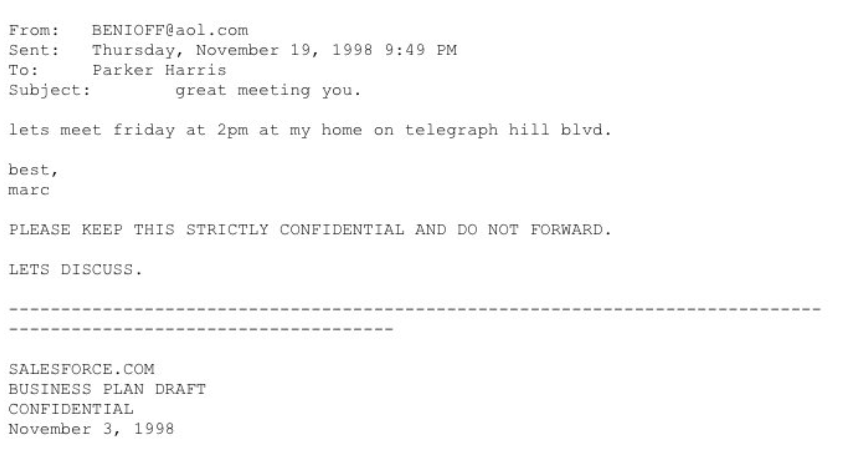
Original meeting request email from Marc Benioff to Parker Harris from 1998 (Email courtesy of Parker Harris)
You have to remember that in 1999, there was no concept of Infrastructure as a Service. It would be years before Amazon launched Amazon Elastic Compute Cloud in 2006, so Harris and his intrepid programming team were on their own when it came to building the software and providing the servers for it to scale and grow.
“I think in a way, that’s part of what made us successful, because we knew that we had to, first of all, imagine scale for the world,” Harris said. It wasn’t a matter of building one CRM tool for a large company and scaling it to meet that individual organization’s demand, then another, it was really about figuring out how to let people just sign up and start using the service, he said.
“I think in a way, that’s part of what made us successful because we knew that we had to, first of all, imagine scale for the world.” Parker Harris, Salesforce
That may seem trivial now, but it wasn’t a common way of doing business in 1999. The internet in those years was dominated by a ton of consumer-facing dot-coms, many of which would go bust in the next year or two. Salesforce wanted to build an enterprise software company online, and although it wasn’t alone in doing that, it did face unique challenges being one of the early adherents.
“We created a software that was what I would call massively multi-tenant where we couldn’t optimize it at the hardware layer because there was no Infrastructure as a Service. So we did all the optimization above that — and we actually had very little infrastructure early on,” he explained.
Running down a dream
From the beginning, Benioff had the vision and Harris was charged with building it. Tien Tzuo, who would go on to be co-founder at Zuora in 2007, was employee number 11 at Salesforce, starting in August of 1999, about five months after the apartment opened for business. At that point, there still wasn’t an official product, but they were getting closer when Benioff hired Tzuo.
As Tzuo tells it, he had fancied a job as a product manager, but when Benioff saw his Oracle background in sales, he wanted him in account development. “My instinct was, don’t argue with this guy. Just roll with it,” Tzuo relates.
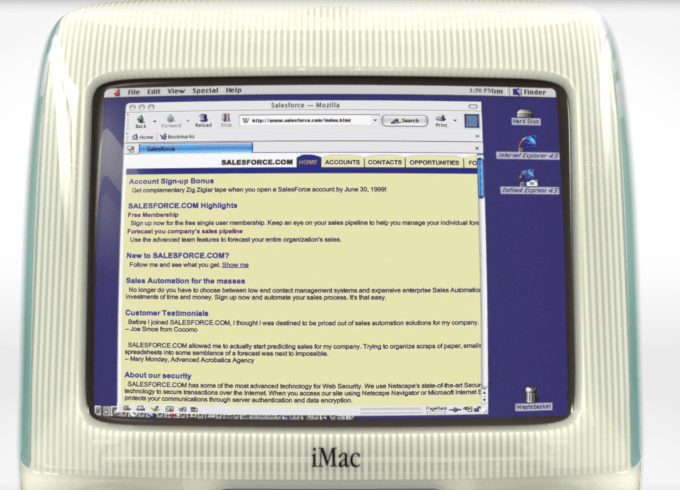
Early prototype of Salesforce.com (Photo: Salesforce)
As Tzuo pointed out, in a startup with a handful of people, titles mattered little anyway. “Who cares what your role was. All of us had that attitude. You were a coder or a non-coder,” he said. The coders were stashed upstairs with a view of San Francisco Bay and strict orders from Benioff to be left alone. The remaining employees were downstairs working the phones to get customers.
“Who cares what your role was. All of us had that attitude. You were a coder or a non-coder.” Tien Tzuo, early employe
The first Wayback Machine snapshot of Salesforce.com is from November 15, 1999, It wasn’t fancy, but it showed all of the functionality you would expect to find in a CRM tool: Accounts, Contacts, Opportunities, Forecasts and Reports, with each category represented by a tab.
The site officially launched on February 7, 2000 with 200 customers, and they were off and running.
Prove it all night
Every successful startup needs visionary behind it, pushing it, and for Salesforce that person was Marc Benioff. When he came up with the concept for the company, the dot-com boom was in high gear. In a year or two, much of it would come crashing down, but in 1999, anything was possible, and Benioff was bold and brash and brimming with ideas.
But even good ideas don’t always pan out for so many reasons, as many a failed startup founder knows only too well. For a startup to succeed it needs a long-term vision of what it will become, and Benioff was the visionary, the front man, the champion, the chief marketer. He was all of that — and he wouldn’t take no for an answer.
Paul Greenberg, managing principal at The 56 Group and author of multiple books about the CRM industry, including CRM at the Speed of Light (the first edition of which was published in 2001), was an early user of Salesforce, and says that he was not impressed with the product at first, complaining about the early export functionality in an article.
A Salesforce competitor at the time, Salesnet, got wind of Greenberg’s post, and put his complaint on the company website. Benioff saw it, and fired off an email to Greenberg: “I see you’re a skeptic. I love convincing skeptics. Can I convince you?” Greenberg said that being a New Yorker, he wrote back with a one-line response. “Take your best shot.” Twenty years later, Greenberg says that Benioff did take his best shot — and he did end up convincing him.
“I see you’re a skeptic. I love convincing skeptics. Can I convince you?” Early Marc Benioff email
Laurie McCabe, who is co-founder and partner at SMB Group, was working for a consulting firm in Boston in 1999 when Benioff came by to pitch Salesforce to her team. She says she was immediately impressed with him, but also with the notion of putting enterprise software online, effectively putting it within reach of many more companies.
“He was the ringmaster I believe for SaaS or cloud or whatever we want to call it today. And that doesn’t mean some of these other guys didn’t also have a great vision, but he was the guy beating the drum louder. And I just really felt that in addition to the fact that he was an exceptional storyteller, marketeer and everything else, he really had the right idea that software on prem was not in reach of most businesses,” she said.
Take it to the limit
One of the ways that Benioff put the company in the public eye in the days before social media was guerrilla marketing techniques. He came up with the idea of “no software” as a way to describe software on the internet. He sent some of his early employees to “protest” at the Siebel Conference, taking place at the Moscone Center in February, 2000. He was disrupting one of his major competitors, and it created enough of a stir to attract a television news crew and garner a mention in The Wall Street Journal. All of this was valuable publicity for a company that was still in its early stages.
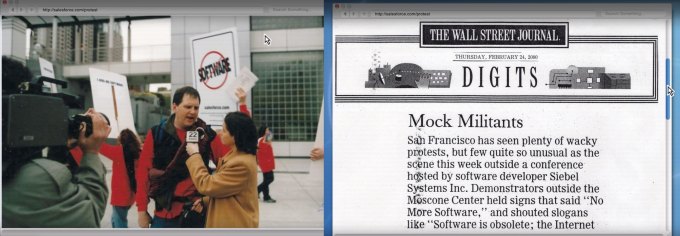
Photos: Salesforce
Brent Leary, who had left his job as an industry consultant in 2003 to open his current firm, CRM Essentials, said this ability to push the product was a real differentiator for the company and certainly got his attention. “I had heard about Salesnet and these other ones, but these folks not only had a really good product, they were already promoting it. They seemed to be ahead of the game in terms of evangelizing the whole “no software” thing. And that was part of the draw too,” Leary said of his first experiences working with Salesforce.
Leary added, “My first Dreamforce was in 2004, and I remember it particularly because it was actually held on Election Day 2004 and they had a George W. Bush look-alike come and help open the conference, and some people actually thought it was him.”
Greenberg said that the “no software” campaign was brilliant because it brought this idea of delivering software online to a human level. “When Marc said, ‘no software’ he knew there was software, but the thing with him is, that he’s so good at communicating a vision to people.” Software in the 1990s and early 2000s was delivered mostly in boxes on CDs (or 3.5-inch floppies), so saying no software was creating a picture that you didn’t have to touch the software. You just signed up and used it. Greenberg said that campaign helped people understand online software at a time when it wasn’t a common delivery method.
Culture club
One of the big differentiators for Salesforce as a company was the culture it built from Day One. Benioff had a vision of responsible capitalism and included their charitable 1-1-1 model in its earliest planning documents. The idea was to give one percent of Salesforce’s equity, one percent of its product and one percent of its employees’ time to the community. As Benioff once joked, they didn’t have a product and weren’t making any money when they made the pledge, but they have stuck to it and many other companies have used the model Salesforce built.
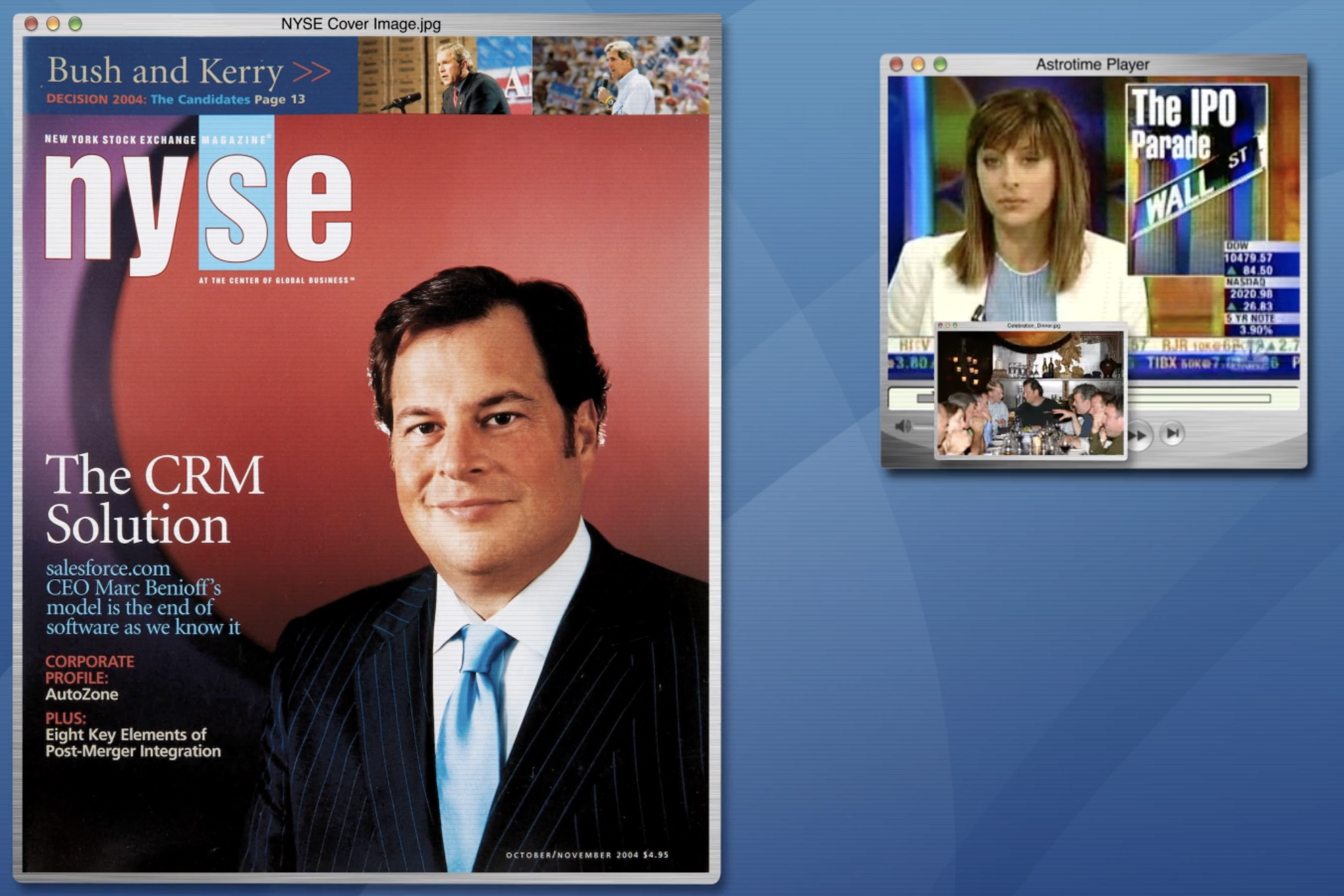
Image: Salesforce
Bruce Cleveland, a partner at Wildcat Ventures, who has written a book with Geoffrey Moore (of Crossing the Chasm fame) called Traversing the Traction Gap, says that it is essential for a startup to establish a culture early on, just as Benioff did. “A CEO has to say, these are the standards by which we’re going to run this company. These are the things that we value. This is how we’re going to operate and hold ourselves accountable to each other,” Cleveland said. Benioff did that.
Another element of this was building trust with customers, a theme that Benioff continues to harp on to this day. As Harris pointed out, people still didn’t trust the internet completely in 1999, so the company had to overcome objections to entering a credit card online. Even more than that though, they had to get companies to agree to share their precious customer data with them on the internet.
“We had to not only think about scale, we had to think about how do we get the trust of our customers, to say that we will protect your information as well or better than you can,” Harris explained.
Growing up
The company was able to overcome those objections, of course, and more. Todd McKinnon, who is currently co-founder and CEO at Okta, joined Salesforce as VP of Engineering in 2006 as the company began to ramp up becoming a $100 million company, and he says that there were some growing pains in that time period.

Salesforce revenue growth across the years, from 2006-present (Chart: Macro Trends)
When he arrived, they were running on three mid-tier Sun servers in a hosted co-location facility. McKinnon said that it was not high-end by today’s standards. “There was probably less RAM than what’s in your MacBook Pro today,” he joked.
When he came on board, the company still had only 13 engineers and the actual infrastructure requirements were still very low. While that would change during his six-year tenure, it was working fine when he got there. Within five years, he said, that changed dramatically as they were operating their own data centers and running clusters of Dell X86 servers — but that was down the road.
Before they did that, they went back to Sun one more time and bought four of the biggest boxes they sold at the time and proceeded to transfer all of the data. The problem was that the Oracle database wasn’t working well, so, as McKinnon tells it, they got on the phone with Larry Ellison from Oracle, who upon hearing about the setup, asked them straight out why they were doing that? The way they had it set up simply didn’t work.
They were able to resolve it all and move on, but it’s the kind of crisis that today’s startups probably wouldn’t have to deal with because they would be running their company on a cloud infrastructure service, not their own hardware.
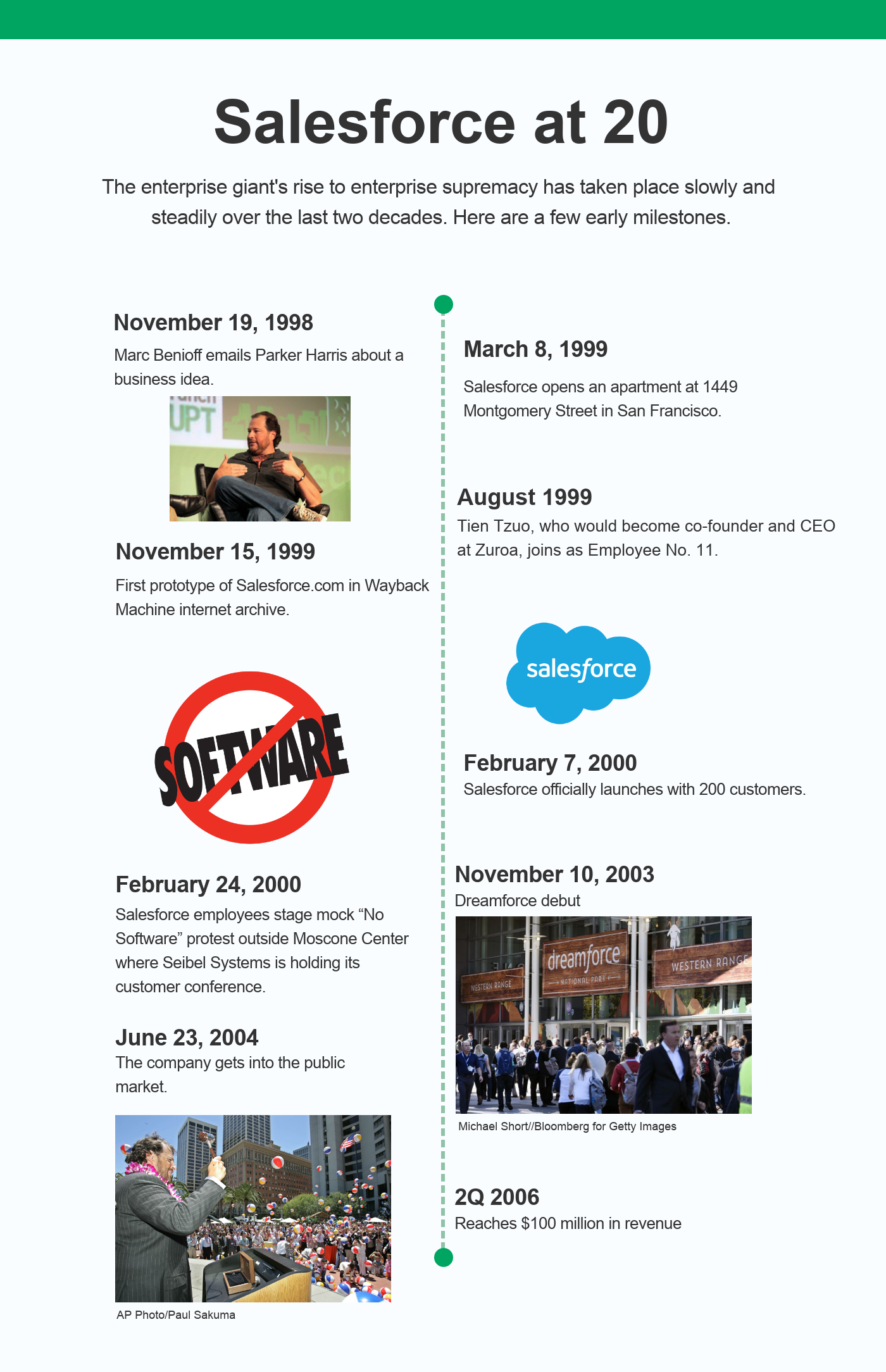
Window shopping
About this same time, Salesforce began a strategy to grow through acquisitions. In 2006, it acquired the first of 55 companies when it bought a small wireless technology company called Sendia for $15 million. As early as 2006, the year before the first iPhone, the company was already thinking about mobile.
Last year it made its 52nd acquisition, and the most costly so far, when it purchased MuleSoft for $6.5 billion, giving it a piece of software that could help Salesforce customers bridge the on-prem and cloud worlds. As Greenberg pointed out, this brought a massive change in messaging for the company.
“With the Salesforce acquisition of MuleSoft, it allows them pretty much to complete the cycle between back and front office and between on-prem and the cloud. And you notice, all of a sudden, they’re not saying ‘no software.’ They’re not attacking on-premise. You know, all of this stuff has gone by the wayside,” Greenberg said.
No company is going to be completely consistent as it grows and priorities shift, but if you are a startup looking for a blueprint on how to grow a successful company, Salesforce would be a pretty good company to model yourself after. Twenty years into this, they are still growing and still going strong and they remain a powerful voice for responsible capitalism, making lots of money, while also giving back to the communities where they operate.
One other lesson you could learn is that you’re never done. Twenty years is a big milestone, but it’s just one more step in the long arc of a successful organization.
Powered by WPeMatico
YC’s latest moonshot bet is a startup building a $380K ‘flying motorcycle’
David Mayman has a vision for personal aviation that he’s spent the past dozen years and millions of his personal fortune chasing. He hasn’t accepted the convention that jetpacks were just a misguided fantasy for the future; his company, Jetpack Aviation, has been building them and he’s been zooming around in publicity-grabbing stunts in a plea to the public that there’s room to dream when it comes to human flight.
And while an eight-person startup aiming to build out a fleet of $380,000 “flying motorcycles” might seem like a tall order, Y Combinator, a top accelerator known for its occasionally bizarre bets, is gambling on the company and its jet engine-obsessed CEO in one of its latest investments.
Jetpack Aviation is about to become a very different company. The startup has launched pre-orders this week for the moonshot of moonshots, the Speeder, a personal vertical take-off and landing vehicle with a svelte concept design that looks straight out of Star Wars or Halo.
Deep-pocketed, sci-fi-minded buyers are going to have to fork over $10,000 just to get a spot in the pre-order line for the first vehicles to ship, but the startup’s founder seems to see the campaign as less about the money than it is about the confirmation that there are people interested in planting a stake in his wild company’s future success.
“I think it’s a validation statement for all of us,” Mayman tells TechCrunch. “If you look at how long Tesla took to deliver the Model 3 to customers, I think people understand that this is not something that’s a Kickstarted pre-delivery campaign where at the tail-end of it we’re immediately going to be delivering product.”
There are gambles and then there are flying motorcycles. This is frankly an atypical startup for YC to fund, but it is also an unconventional business path for Mayman, who has largely been self-financing his jetpack-building obsession for the past 12 years. For the Australian CEO, the YC investment is mainly about gaining access to Silicon Valley’s network of VCs, though he also acknowledges it’s a fair assumption that SF breeds the type of executive that might be interested in pre-ordering something so seemingly outlandish.
While much of the excitement Mayman has raised for his company’s jetpacks has relied on the spectacle of prototype demos in front of throngs of news networks (Jetpack Aviation has unsurprisingly partnered with Red Bull), the company has yet to build a full-scale prototype of the Speeder, though he says their new round of funding should get them there.

Mayman flying a jetpack around the Statue of Liberty in 2015
Can they actually build this? That’s seems to be a pretty valid question.
In our conversation, Mayman acknowledges upfront that:
- The Speeder is “at least” two years of development time away from ending up in customer hands.
- The company will have to raise “tens of millions” of dollars to ship this design.
- There are still plenty of unknowns.
Jetpack Aviation’s current design is more ambitious than most helicopter-shaped concept VTOL vehicles being pursued by companies like Uber, namely due to its relatively sleek design where the human rider is directly above a set of several gimbal-mounted jet engines.
The company claims finished designs will move faster than 150 mph at altitudes up to 15,000 feet. The flight time is still a limiting factor; max flight times for the models are estimated to be around 30 minutes. The company is planning a number of versions, including an ultralight model that complies with some federal regulations and won’t require a pilot’s license, the company says.
The startup’s most pertinent problem is creating the autonomous stabilization technologies that will make flying the Speeder effortless and safe. Mayman notes that most VTOL designs look like quadcopters simply because the physics of putting weight directly on top of the thrust system is so challenging. “It’s like trying to balance a pencil on your finger,” he says.
His team has been training people to use their jetpacks — now in their 11th design iteration — and say it takes about a week to get potential flyers up-and-running with the particulars of the system. But Mayman says he wants this to be a device that just works, a design concept that made a lot of sense when Steve Jobs was using it to refer to the simplicity of the iPad, but feels a tad more aggressive when presented with the rendered images of someone flying this thing over city centers:
A lot of the industry’s existing work around autonomous flight and stabilization for drone aircraft really doesn’t account for Jetpack Aviation’s design, though Mayman says they’ve already made some significant progress with their 1:3 scale prototype. He also notes that the company does have a “less elegant-looking” plan-B design if they determine the centrally clustered jet engines are too much of a stabilization liability.
Indeed, the key for getting a concept like this off the ground and ensuring the company doesn’t miserably fail is being flexible about how this vision matures, Mayman says, noting that they’re approaching the vehicle with multiple designs and multiple considerations for how the regulatory environment for certification shapes up, including work on a separate military version and consideration for designs more focused on emergency response like rapid medical evacuation.
Asked whether pre-orderers plunking down $10K might be disappointed by a different-looking product, the founder said that they’ve done enough modeling to know that what they build will fall into a roughly similar design. “It may not look exactly like what we’ve rendered, but I’m confident that it’s still going to be the same sort of concept, a motorcycle or jet-ski size and shape.”
It is certainly a unique choice for the company to launch its pre-orders already with so much in the air, but it’s fairly apparent that they are looking to emulate Tesla here, and if people with nearly $400K to throw around want to buy a jet-engine jet-ski, then by all means, let the free market do its thing.
Y Combinator’s $150,000 investment is an early step for the moonshot effort and a vote of confidence that places them on others’ radar. Mayman, for his part, does seem genuinely thrilled about expanding the ambitions of his passion project, even if the road ahead is crowded with obstacles for realizing the vision.
“If you don’t start it, you’re never going to get there,” Mayman says. “If our guys weren’t able to wake up every morning saying, ‘Holy shit, this would be freaking amazing if we can build this,’ then it’s sort of not worth doing. We might as well go do something else.”
Powered by WPeMatico
Instagram prototypes video co-watching
The next phase of social media is about hanging out together while apart. Rather than performing on a live stream or engaging with a video chat, Instagram may allow you to chill and watch videos together with a friend. Facebook already has Watch Party for group co-viewing, and in November we broke the news that Facebook Messenger’s code contains an unreleased “Watch Videos Together” feature. Now Instagram’s code reveals a “co-watch content” feature hidden inside Instagram Direct Messaging.
It’s unclear what users might be able to watch simultaneously, but the feature could give IGTV a much-needed boost, or just let you laugh and cringe at Instagram feed videos and Stories. But either way, co-viewing could make you see more ads, drive more attention to creators that will win Instagram their favor or just make you rack up time spent on the app without forcing you to create anything.

The Instagram co-watch code was discovered by TechCrunch’s favorite tipster and reverse-engineering specialist Jane Manchun Wong, who previously spotted the Messenger Watch Together code. Her past findings include Instagram’s video calling, music soundtracks and Time Well Spent dashboard, months before they were officially released. The code mentions that you can “cowatch content” that comes from a “Playlist” similar to the queues of videos Facebook Watch Party admins can tee up. Users could also check out “Suggested” videos from Instagram, which would give it a new way to promote creators or spawn a zeitgeist moment around a video. It’s not certain whether users will be able to appear picture-in-picture while watching so friends can see their reactions, but that would surely be more fun.
Instagram declined to comment on the findings, which is typical of the company when a feature has been prototyped internally but hasn’t begun externally testing with users. At this stage, products can still get scrapped or take many months or even more than a year to launch. But given Facebook’s philosophical intention to demote mindless viewing and promote active conversation around videos, Instagram co-watching is a sensible direction.
Facebook launched Watch Party to this end back in July, and by November, 12 million had been started from Groups and they generated 8X more comments than non-synced or Live videos. That proves co-watching can make video feel less isolating. That’s important as startups like Houseparty group video chatrooms and Squad screenshare messaging try to nip at Insta’s heels.

It’s also another sign that following the departure of the Instagram founders, Facebook has been standardizing features across its apps, eroding their distinct identities. Mark Zuckerberg plans to unify the backend of Facebook Messenger, WhatsApp, and Instagram to allow cross-app messaging. But Instagram has always been Facebook’s content-first app, so while Watch Party might have been built for Facebook Groups, Instagram could be where it hits its stride.
Speaking of the Instagram founders Kevin Systrom and Mike Krieger, this article’s author Josh Constine will be interviewing them on Monday 3/11 at SXSW. Come see them at 2 pm in the Austin Convention Center’s Ballroom D to hear about their thoughts on the creator economy, why they left Facebook and what they’ll do next. Check out the rest of TechCrunch’s SXSW panels here, and RSVP for our party on Sunday.
Powered by WPeMatico
WellSaid aims to make natural-sounding synthetic speech a credible alternative to real humans
Many things are better said than read, but the best voice tech out there seems to be reserved for virtual assistants, not screen readers or automatically generated audiobooks. WellSaid wants to enable any creator to use quality synthetic speech instead of a human voice — perhaps even a synthetic version of themselves.
There’s been a series of major advances in voice synthesis over the last couple of years as neural network technology improves on the old highly manual approach. But Google, Apple and Amazon seem unwilling to make their great voice tech available for anything but chirps from your phone or home hub.
As soon as I heard about WaveNet, and later Tacotron, I tried to contact the team at Google to ask when they’d get to work producing natural-sounding audiobooks for everything on Google Books, or as a part of AMP, or make it an accessibility service, and so on. Never heard back. I considered this a lost opportunity, as there are many out there who need such a service.
So I was pleased to hear that WellSaid is taking on this market, after a fashion, anyway. The company is the first to launch from the Allen Institute for AI (AI2) incubator program announced back in 2017. They do take their time!
Talk the talk
I talked with the co-founders CEO Matt Hocking and CTO Michael Petrochuk, who explained why they went about creating a whole new system for voice synthesis. The basic problem, they said, is that existing systems not only rely on a lot of human annotation to sound right, but they “sound right” the exact same way every time. You can’t just feed it a few hours of audio and hope it figures out how to inflect questions or pause between list items — much of this stuff has to be spelled out for them. The end result, however, is highly efficient.
 “Their goal is to make a small model for cheap [i.e. computationally] that pronounces things the same way every time. It’s this one perfect voice,” said Petrochuk. “We took research like Tacotron and pushed it even further — but we’re not trying to control speech and enforce this arbitrary structure on it.”
“Their goal is to make a small model for cheap [i.e. computationally] that pronounces things the same way every time. It’s this one perfect voice,” said Petrochuk. “We took research like Tacotron and pushed it even further — but we’re not trying to control speech and enforce this arbitrary structure on it.”
“When you think about the human voice, what makes it natural, kind of, is the inconsistencies,” said Hocking.
And where better to find inconsistencies than in humans? The team worked with a handful of voice actors to record dozens of hours of audio to feed to the system. There’s no need to annotate the text with “speech markup language” to designate parts of sentences and so on, Petrochuk said: “We discovered how to train off of raw audiobook data, without having to do anything on top of that.”
So WellSaid’s model will often pronounce the same word differently, not because a carefully manicured manual model of language suggested it do so, but because the person whose vocal fingerprint it is imitating did so.
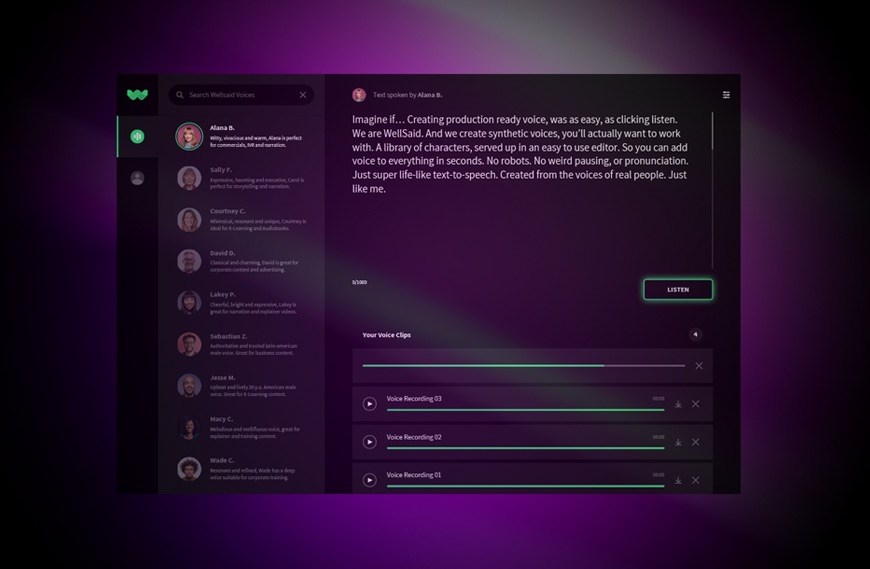 And how does that work, exactly? That question seems to dip into WellSaid’s secret sauce. Their model, like any deep learning system, is taking innumerable inputs into account and producing an output, but it is larger and more far-reaching than other voice synthesis systems. Things like cadence and pronunciation aren’t specified by its overseers but extracted from the audio and modeled in real time. Sounds a bit like magic, but that’s often the case when it comes to bleeding-edge AI research.
And how does that work, exactly? That question seems to dip into WellSaid’s secret sauce. Their model, like any deep learning system, is taking innumerable inputs into account and producing an output, but it is larger and more far-reaching than other voice synthesis systems. Things like cadence and pronunciation aren’t specified by its overseers but extracted from the audio and modeled in real time. Sounds a bit like magic, but that’s often the case when it comes to bleeding-edge AI research.
It runs on a CPU in real time, not on a GPU cluster somewhere, so it can be done offline as well. This is a feat in itself, as many voice synthesis algorithms are quite resource-heavy.
What matters is that the voice produced can speak any text in a very natural-sounding way. Here’s the first bit of an article — alas, not one of mine, which would have employed more mellifluous circumlocutions — read by Google’s WaveNet, then by two of WellSaid’s voices.
The latter two are definitely more natural sounding than the first. On some phrases the voices may be nearly indistinguishable from their originals, but in most cases I feel sure I could pick out the synthetic voice in a few words.
That it’s even close, however, is an accomplishment. And I can certainly say that if I was going to have an article read to my by one of these voices, it would be WellSaid’s. Naturally it can also be tweaked and iterated, or effects applied to further manipulate the sound, as with any voice performance. You didn’t think those interviews you hear on NPR are unedited, did you?
The goal at first is to find the creatives whose work would be improved or eased by adding this tool to their toolbox.
“There are a lot of people who have this need,” explained Hocking. “A video producer who doesn’t have the budget to hire a voice actor; someone with a large volume of content that has to be iterated on rapidly; if English is a second language, this opens up a lot of doors; and some people just don’t have a voice for radio.”
It would be nice to be able to add voice with a click rather than just have block text and royalty-free music over a social ad (think the admen):
I asked about the reception among voice actors, who of course are essentially being asked to train their own replacements. They said that the actors were actually positive about it, thinking of it as something like stock photography for voice; get a premade product for cheap, and if you like it, pay the creator for the real thing. Although they didn’t want to prematurely lock themselves into future business models, they did acknowledge that revenue share with voice actors was a possibility. Payment for virtual representations is something of a new and evolving field.
A closed beta launches today, which you can sign up for at the company’s site. They’re going to be launching with five voices to start, with more voices and options to come as WellSaid’s place in the market becomes clear. Part of that process will almost certainly be inclusion in tools used by the blind or otherwise disabled, as I have been hoping for years.
Sounds familiar
And what comes after that? Making synthetic versions of users’ voices, of course. No brainer! But the two founders cautioned that’s a ways off for several reasons, even though it’s very much a possibility.
“Right now we’re using about 20 hours of data per person, but we see a future where we can get it down to one or two hours while maintaining a premium lifelike quality to the voice,” said Petrochuk.
“And we can build off existing data sets, like where someone has a back catalog of content,” added Hocking.
The trouble is that the content may not be exactly right for training the deep learning model, which advanced as it is can no doubt be finicky. There are dials and knobs to tweak, of course, but they said that fine-tuning a voice is more a matter of adding corrective speech, perhaps having the voice actor reading a specific script that props up the sounds or cadences that need a boost.
They compared it with directing such an actor rather than adjusting code. You don’t, after all, tell an actor to increase the pauses after commas by 8 percent or 15 milliseconds, whichever is longer. It’s more efficient to demonstrate for them: “say it like this.”
Even so, getting the quality just right with limited and imperfect training data is a challenge that will take some serious work if and when the team decides to take it on.
But as some of you may have noticed, there are also some parallels to the unsavory world of “deepfakes.” Download a dozen podcasts or speeches and you’ve got enough material to make a passable replica of someone’s voice, perhaps a public figure. This of course has a worrying synergy with the existing ability to fake video and other imagery.
This is not news to Hocking and Petrochuk. If you work in AI, this kind of thing is sort of inevitable.
“This is a super important question and we’ve considered it a lot,” said Petrochuk. “We come from AI2, where the motto is ‘AI for the common good.’ That’s something we really subscribe to, and that differentiates us from our competitors who made Barack Obama voices before they even had an MVP [minimum viable product]. We’re going to watch closely to make sure this isn’t being used negatively, and we’re not launching with the ability to make a custom voice, because that would let anyone create a voice from anyone.”
Active monitoring is just about all anyone with a potentially troubling AI technology can be expected to do — though they are looking at mitigation techniques that could help identify synthetic voices.
With the ongoing emphasis on multimedia presentation of content and advertising rather than written, WellSaid seems poised to make an early play in a growing market. As the product evolves and improves, it’s easy to picture it moving into new, more constrained spaces, like time-shifting apps (instant podcast with five voices to choose from!) and even taking over territory currently claimed by voice assistants. Sounds good to me.
Powered by WPeMatico
Camelot lets Twitch and YouTube audiences pay for what they want to see
As the streaming world continues to grow, startups are looking to take advantage of the opportunity and grab a slice of the pie, and indeed create new revenue models around it entirely.
Camelot, a YC-backed startup, is one of them.
Camelot allows viewers to place bounties on their favorite streamers, putting a monetary value on the things they want to see on stream. This could include in-game challenges like “win with no armor,” as well as stream bounties like “Play Apex” or “add a heartbeat monitor to the stream.”
When a viewer posts a bounty, other viewers can join in and contribute to the overall value, and the streamer can then choose whether or not to go through with it from an admin dashboard.
Because internet platforms can often be used for evil alongside good, cofounder and CEO Jesse Zhang has thought through ways to minimize inappropriate requests.
There is an option for streamers to see and approve the bounty before it’s ever made public to ensure that they avoid inappropriate propositions. Bounties are also paid for up front by viewers, and either returned if the creator declines the bounty or pushed through when the streamer completes the task, raising the barrier to entry for nefarious users.
Camelot generates revenue by taking a five percent stake in every bounty completed.
The platform isn’t just for Twitch streamers — YouTubers can also get in on the mix using Camelot and making asynchronous videos around each bounty. Not only does it offer a new way to generate revenue, but it also offers content creators the chance to get new insights on what their viewers want to see and what they value.
Cofounder and CEO Jesse Zhang believes there is opportunity to expand to streamers and YouTube content creators outside of the gaming sphere in the future.
For now, however, Camelot is working to bring on more content creators. Thus far, streamers and viewers have already come up with some interesting use cases for the product. One streamer’s audience bought his dog some treats, and one viewer of Sa1na paid $100 to play against the streamer himself.
Camelot declined to share how much funding it has received thus far, but did say that lead investors include Y Combinator, the Philadelphia 76ers, Soma Capital, and Plaid cofounders William Hockey and Zach Perret.
Powered by WPeMatico

